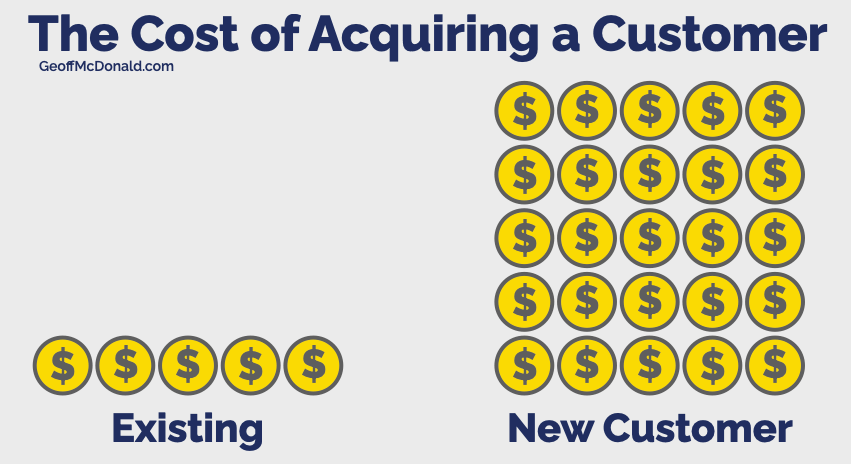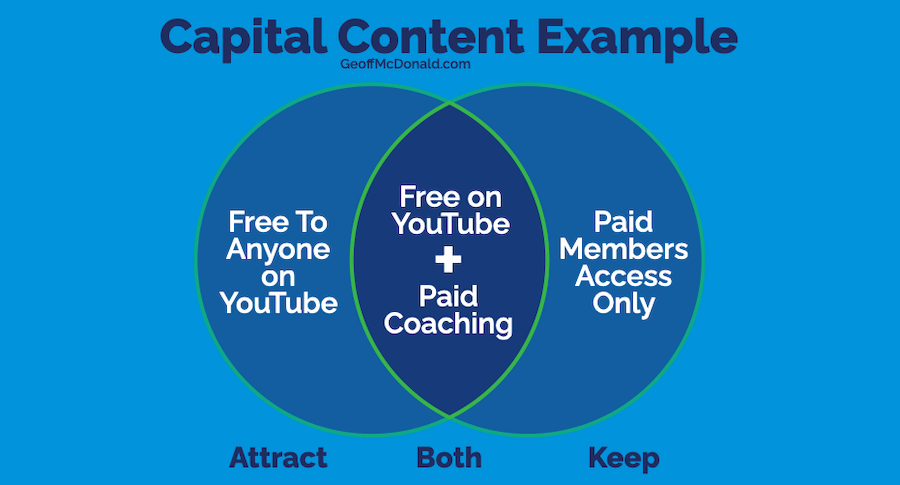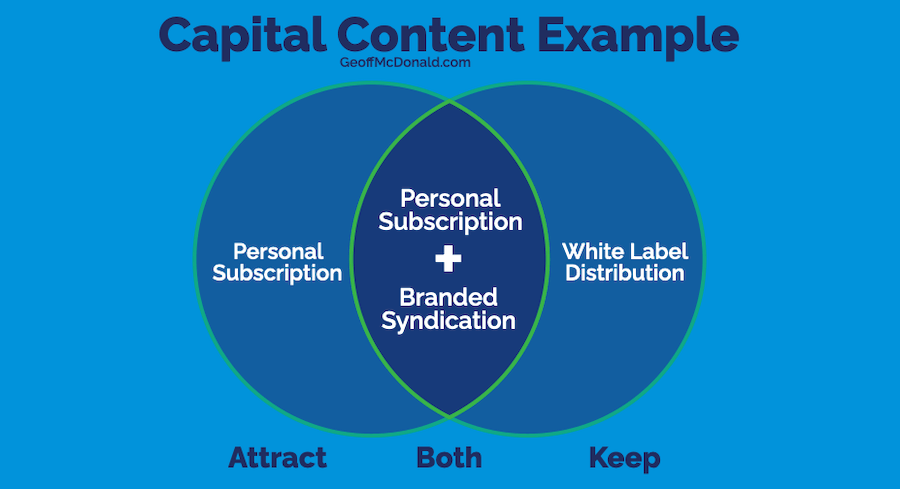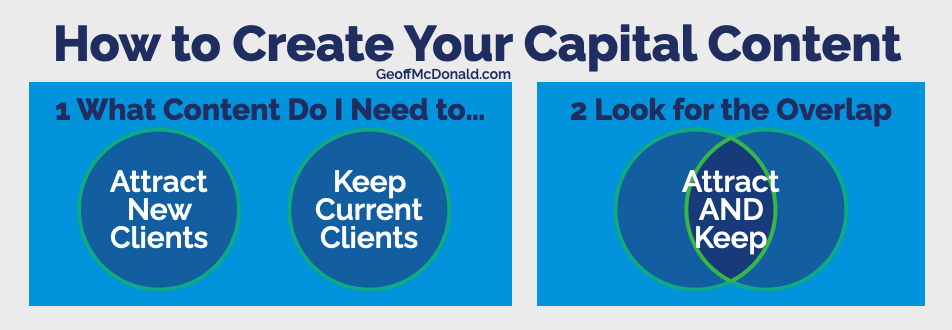The daring content creation idea that doubles your results
The single biggest challenge for all solo business professionals is to balance the need to service your existing clients while also attracting new ones.
In this post, I’ll show a daring content creation idea that doubles your results and addresses this age-old business challenge. It’s especially relevant to professional service firms and individual thought leaders and consultants.
The Great Solo Business Challenge
Every business has the same challenge – getting and keeping customers and clients.
But for solo operators – especially thought leaders and business experts – there is a special challenge around this.
What tends to happen is that we need to earn some money, so we put in a big effort into attracting new clients. If this goes well we gain some new clients. Yay! But then we become busy providing value to these clients and typically we no longer have time for our marketing. So, we stop our marketing and happily focus on serving our current clients. But at some point, the current projects dry up and we’re stuck with no work again.

Photo by Chris Gallagher on Unsplash
This is the boom-bust cycle of business. We constantly bounce from drought to flood and back again.
Our Content Creation follows in a similar way. It’s often boom-bust. We’re either busy creating a flood of new content or we’re starving in a drought of old or existing content.
In this post, I’ll show you an alternative – a daring content creation idea that will double your results and help you avoid the boom and bust of the flood and drought approach.
The Purpose of Content Creation

Why would we want to create content? That’s a pretty obvious question for all content marketers and thought leaders who live and die on the quality of the content they create.
To explore this crucial question, we need to start with why we might want to create content in the first place. And to answer it, we need to ask a deeper question… What’s the purpose of business?
Do you recognize the man in this photo? It’s Peter Drucker. He is one of the most widely known and most influential management thinkers of all time. He’s particularly well known for having concise and valuable insights about the core fundamentals of what makes a successful business.
One of his most famous quotes is: ‘The purpose of a business is to create and keep a customer.’
Which provides a perfect way to describe the purpose of your content, ‘to create and keep a customer’.
The Two Content Creation Goals
This definition gives us two obvious content creation goals.
- One, we can produce content to attract or get customers.
- Two, we can produce content to keep and service our existing customers.
But which is better?
In my previous video, The Five to 25 times better content marketing strategy, I shared the big flaw in most people’s content marketing strategy. Most people solely focus their content marketing efforts on attracting new clients.
But in 2014, Amy Gallo wrote a Harvard Business Review article, The Value of Keeping the Right Customers. She reported that it is anywhere from five to 25 times more expensive to attract a new customer than service an existing one. In other words, it is five to 25 times cheaper to serve your existing clients.
If you are going to focus on only one of these – getting customers or keeping customers, it’s better to focus on serving your existing customers.
But there is a third way.
Capital Content

Capital Content is a daring content creation idea. To understand it fully, let’s explore what the word ‘capital’ means – it has a couple of different meanings.
Traditionally, the word ‘capital’ refers to the head or the top of something. You might instantly think ‘capital city’ – like Canberra – the capital of Australia, Washington DC – the capital of the US or Tokyo the capital of Japan.
For me, as an ex-architect, when I think of capital I think of the head or the top of a column.
Plus, I’ve also spoken about capital in previous videos. In Thought Leadership Strategy, the focus was on capital as ‘any resource that helps you build wealth‘. The three things every thought leader must build are:
- Financial or Money capital
- Social or People capital
- Ideas or Intellectual capital
The Third Way
When we’re talking about content creation, we’re naturally including these three types of capital. We’re creating and sharing ideas to attract and serve people so we can earn money. In other words, we’re creating intellectual capital to build social capital to build financial capital.
This gives us our two content creation goals – content to attract new clients and content to serve our current clients.
In this post, I propose a third content creation goal: your Capital Content.
Instead of having separate goals to attract clients and another to keep clients, it would be more efficient and more effective to unite them into a single goal.
It’s watering two plants with one hose. This is your Capital Content – a single set of content that serves both purposes.
In this way, your Capital Content can double your results because one effort produces two results. It’s your Capital Content because it is your head or top content. Also, it’s your Capital Content because it’s the key to build wealth for your business.
Three Capital Content Examples
Let’s look at some examples…
1 Video Content and Coaching
Each week I create a post and video like this one.
I could have simply published them all on YouTube – this would generate an audience but not earn money. Or I could have put them all behind a paywall and given access to fee-paying subscribers. This would earn me some money but not attract new clients.
Can you see the dilemma here?
But what’s the third way?
The key is to answer this question: How do you attract new clients and serve your current clients at the same time?
To answer this question, I have chosen to put all of my videos on YouTube so everyone can access them for free.
In this way, my videos become the best advertisement for my business coaching. They show people how I think about business, they add value to the people watching them and if someone watches them and likes them, they select themselves as my best potential clients.
To earn money, people pay me to coach them based on the ideas presented in the videos. This can happen in two ways. I can either ask my clients to watch the videos before I coach them – ‘watch this and then we’ll discuss how you can apply this’. Or I can coach them and say ‘watch this video for more information’.
My videos are Capital Content because they help me attract new clients and I also actively use them to serve my current clients.
2 Writing and Publishing a Book
A popular way to create Capital Content is to write a book.
Books let you attract new clients and serve existing ones in a couple of ways:
- You can sell your book and at the same time take content slices out of your book and publish them as blog posts or articles that upsell to your book.
- By having your book on display in retail outlets you can reach new customers and sell your product at the same time.
- Give your book away to entice new clients and you can sell your book to clients to give to their clients.
- Use your book as a coaching tool as I do with my videos. You could say to your client, ‘Read this chapter before we meet next, and we’ll apply this to your business.’
- Further, while you are writing your book you can be testing out your ideas in blog posts to attract existing clients while also testing it with your current clients.
Simply put, you can sell your book and you can also give it away in part or in whole.
3 Book Rapper and Content Syndication
Another way to create Capital Content is through Syndication.
Previously, I ran a book summary service called Book Rapper. My specialty was to rewrite the key points from the book in a visual way. I sold Book Rapper in two ways.
- You could buy a personal subscription allowing you to access all of the issues.
- Or you could buy a syndication licence. This offer included your branding on the Book Rapper issues and a licence to distribute them.
Through syndication, I was able to create Capital Content. A client would pay me to brand the content for their business and then they would distribute my content to their audience. This meant my paying clients shared great content with their audience. And every so often, one of those people would then become a new client for me too.
Another version of syndication is to white-label your content. My book summaries were syndicated because my branding was still on them. I could also have white labelled them and published them without my details on them, but this would not have let people know I was the source of the material which I felt was important because that was a source of new clients for me.
How to Create Your Capital Content
The simple strategy for creating your Capital Content that both attracts new clients and serves current clients is a two-step process.
Step One: Look at the separate needs
Start by looking at the separate needs of each group – attracting new clients and serving your current clients. Write down at least five things each group needs.
- What does a new client customer need? For example, if I’m buying a camera or some software, I want to know that I will be able to use it fully. I’d be looking for tutorials on how to use the camera of software.
- Then, look at what your current clients need.
Step Two: Look for the Overlap
Next, look for the overlap of needs that both groups desire.
In the case of a camera or software, both groups want the same thing. Any potential customer is faced with the risk of ‘will this help me achieve my outcome?’ And the current customer wants also to be able to do it exactly that – achieve their outcome.
A simple and common way to address this is to provide great tutorial videos on how to use your camera or software. As a potential buyer I’ll be able to see the videos and feel comfortable that I can learn how to put my camera or software to good use. And as a purchaser, I can then use the videos to achieve that goal.
This is the key thing to focus on in creating your Capital Content: help people achieve their outcome.
Remember this…
When you’re looking for the overlap, remember our previous point from Amy Gallo: It’s five to 25 times cheaper to service an existing customer than a new one.
This means, if you’re struggling to balance the overlap between the needs of your new customers or your existing ones, then you’re better off erring on the side of your current clients. Best of all, you know exactly who these people are so you can ask them what they need.
Summary of a Daring Content Creation Idea
Let’s wrap up what we’ve covered here around Capital Content…
- The purpose of your business is to attract and serve customers.
- It follows that the purpose of your content creation is also to attract and serve customers.
- Most people deal with this as two separate things.
- But through the daring content creation idea of Capital Content, I encourage you to look for ways to do both at the same time so you can double the results you gain from the same amount of effort. Water two plants with one hose.
- For example, writing a book creates a body of work that you can sell as well as share freely.
More on our Daring Content Creation Idea
If you’d like more daring content creation ideas, here are some other pieces of content I’ve created and shared recently:










